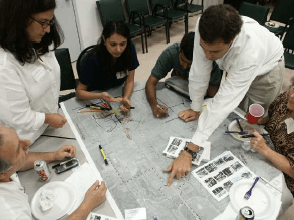Top Story
The Infrastructure Initiative takes a closer look at the State Road 7, profiled in our recent Shifting Suburbs report.
State Road 7, a busy suburban arterial in Broward and Miami-Dade Counties, is one of four suburban arterials explored in the ULI Infrastructure Initiative’s recent report, Shifting Suburbs: Reinventing Infrastructure for Compact Development. The corridor—a busy suburban arterial—is full of potential, but it poses infrastructure and redevelopment challenges too.
ULI and State Road 7 go way back—ULI has been working with stakeholders along the corridor for a long time. In March 2004, a ULI Advisory Services Panel conducted an assessment of regional growth projections along the corridor. The State Road 7.U.S. 441 Collaborative, a group of local government leaders from the 17 municipalities traversed by SR-7, used the panel’s findings to inform the preparation of the corridor’s master plan. The plan seeks to transform SR-7 into a transit-oriented corridor utilizing smart growth principles.
In 2011, Eric Swanson, policy analyst at the South Regional Planning Council, and Gary Rogers, executive director of the City of Lauderdale Lakes’ Community Redevelopment Agency, reported on the Collaborative’s progress at a ULI forum in Minneapolis. Big changes are in the works for the corridor.
Major infrastructure changes to be implemented include the widening of SR-7 to  accommodate future transportation needs in some areas, as well as street-width reductions in others, to facilitate urban-scale redevelopment and accommodate premium transit (such as fixed rail or BRT). Pedestrian amenities, such as high-visibility crosswalks and medians to serve as crossing oases, will also be built. Necessary sewer infrastructure is being constructed. Local transit service is currently provided throughout the corridor but is intended to evolve over time. Express service overlays are being introduced through pilot programs using bus queue jump lanes on SR-7. Eventually, a premium transit system in dedicated lanes will be established using bus or fixed-rail transit.
accommodate future transportation needs in some areas, as well as street-width reductions in others, to facilitate urban-scale redevelopment and accommodate premium transit (such as fixed rail or BRT). Pedestrian amenities, such as high-visibility crosswalks and medians to serve as crossing oases, will also be built. Necessary sewer infrastructure is being constructed. Local transit service is currently provided throughout the corridor but is intended to evolve over time. Express service overlays are being introduced through pilot programs using bus queue jump lanes on SR-7. Eventually, a premium transit system in dedicated lanes will be established using bus or fixed-rail transit.
It is hoped that these infrastructure efforts, coupled with redevelopment of key nodes along the corridor, will help spark reinvestment along SR-7.
The SR-7 effort spans 41 miles, making it the longest revitalization effort in the United States. Despite the economic downturn and the challenges of land assembly and infrastructure installation, the work of reinventing of SR-7 will continue.